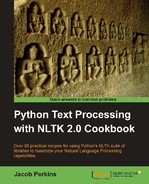- Python Text Processing with NLTK 2.0 Cookbook
- Table of Contents
- Python Text Processing with NLTK 2.0 Cookbook
- Credits
- About the Author
- About the Reviewers
- Preface
- 1. Tokenizing Text and WordNet Basics
- Introduction
- Tokenizing text into sentences
- Tokenizing sentences into words
- Tokenizing sentences using regular expressions
- Filtering stopwords in a tokenized sentence
- Looking up synsets for a word in WordNet
- Looking up lemmas and synonyms in WordNet
- Calculating WordNet synset similarity
- Discovering word collocations
- 2. Replacing and Correcting Words
- 3. Creating Custom Corpora
- Introduction
- Setting up a custom corpus
- Creating a word list corpus
- Creating a part-of-speech tagged word corpus
- Creating a chunked phrase corpus
- Creating a categorized text corpus
- Creating a categorized chunk corpus reader
- Lazy corpus loading
- Creating a custom corpus view
- Creating a MongoDB backed corpus reader
- Corpus editing with file locking
- 4. Part-of-Speech Tagging
- Introduction
- Default tagging
- Training a unigram part-of-speech tagger
- Combining taggers with backoff tagging
- Training and combining Ngram taggers
- Creating a model of likely word tags
- Tagging with regular expressions
- Affix tagging
- Training a Brill tagger
- Training the TnT tagger
- Using WordNet for tagging
- Tagging proper names
- Classifier based tagging
- 5. Extracting Chunks
- Introduction
- Chunking and chinking with regular expressions
- Merging and splitting chunks with regular expressions
- Expanding and removing chunks with regular expressions
- Partial parsing with regular expressions
- Training a tagger-based chunker
- Classification-based chunking
- Extracting named entities
- Extracting proper noun chunks
- Extracting location chunks
- Training a named entity chunker
- 6. Transforming Chunks and Trees
- 7. Text Classification
- Introduction
- Bag of Words feature extraction
- Training a naive Bayes classifier
- Training a decision tree classifier
- Training a maximum entropy classifier
- Measuring precision and recall of a classifier
- Calculating high information words
- Combining classifiers with voting
- Classifying with multiple binary classifiers
- 8. Distributed Processing and Handling Large Datasets
- Introduction
- Distributed tagging with execnet
- Distributed chunking with execnet
- Parallel list processing with execnet
- Storing a frequency distribution in Redis
- Storing a conditional frequency distribution in Redis
- Storing an ordered dictionary in Redis
- Distributed word scoring with Redis and execnet
- 9. Parsing Specific Data
- A. Penn Treebank Part-of-Speech Tags
- Index
In this chapter, we will cover:
- Bag of Words feature extraction
- Training a naive Bayes classifier
- Training a decision tree classifier
- Training a maximum entropy classifier
- Measuring precision and recall of a classifier
- Calculating high information words
- Combining classifiers with voting
- Classifying with multiple binary classifiers
Text classification is a way to categorize documents or pieces of text. By examining the word usage in a piece of text, classifiers can decide what class label to assign to it. A binary classifier decides between two labels, such as positive or negative. The text can either be one label or the other, but not both, whereas a multi-label classifier can assign one or more labels to a piece of text.
Classification works by learning from labeled feature sets, or training data, to later classify an unlabeled feature set. A
feature set is basically a key-value mapping of feature names to feature values. In the case of text classification, the feature names are usually words, and the values are all True. As the documents may have unknown words, and the number of possible words may be very large, words that don't occur in the text are omitted, instead of including them in a feature set with the value False.
An instance is a single feature set. It represents a single occurrence of a combination of features. We will use instance and feature set interchangeably. A labeled feature set is an instance with a known class label that we can use for training or evaluation.
-
No Comment
